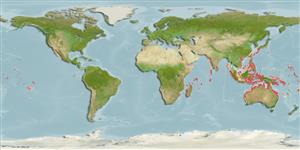>
Anguilliformes (Eels and morays) >
Ophichthidae (Snake eels) > Ophichthinae
Etymology: Yirrkala: Named for its type locality Yirrkala, Caledon Bay, Gulf of Carpentaria, Queensland, Australia..
More on author: Bleeker.
Issue
The genus assignment of the species is from McCosker (2007: Ref. 58467). This species must not be mistaken with Ophisurus lumbricoides Bleeker, 1852 now synonym of Ophichthus rutidoderma (Bleeker 1852).
Environment: milieu / climate zone / depth range / distribution range
Ekologi
marina bottenlevande; djupintervall ? - 20 m (Ref. 3972). Tropical
Indo-Pacific.
Size / Vikt / Age
Maturity: Lm ? range ? - ? cm
Max length : 44.0 cm TL hane/ej könsbestämd; (Ref. 3972)
Life cycle and mating behavior
Maturities | Reproduktion | Spawnings | Egg(s) | Fecundities | Larver
McCosker, J.E., 2007. Luthulenchelys heemstraorum, a new genus and species of snake eel (Anguilliformes: Ophichthidae) from KwaZulu-Natal, with comments on Ophichthus rutidoderma (Bleeker, 1853) and its synonyms. Smithiana Bull. 7:3-7. (Ref. 58467)
IUCN Red List Status (Ref. 130435)
Threat to humans
Harmless
Human uses
Verktyg
Special reports
Download XML
Internet-källor
Estimates based on models
Preferred temperature (Ref.
123201): 21.8 - 29.2, mean 27.7 °C (based on 2113 cells).
Phylogenetic diversity index (Ref.
82804): PD
50 = 0.5000 [Uniqueness, from 0.5 = low to 2.0 = high].
Bayesian length-weight: a=0.00089 (0.00039 - 0.00204), b=3.00 (2.80 - 3.20), in cm total length, based on LWR estimates for this (Sub)family-body shape (Ref.
93245).
Trofisk nivå (Ref.
69278): 3.7 ±0.6 se; based on size and trophs of closest relatives
Resiliens (Ref.
120179): Hög, lägsta populationsfördubblingstid mindre än 15 månader (Preliminary K or Fecundity.).
Fishing Vulnerability (Ref.
59153): Low to moderate vulnerability (34 of 100).
